Nahua Pottery Anthropomorphic Xantil Censer Cover
Lot 117a
About Seller
Artemis Gallery
686 S Taylor Ave, Ste 106
Louisville, CO 80027
United States
Selling antiquities, ancient and ethnographic art online since 1993, Artemis Gallery specializes in Classical Antiquities (Egyptian, Greek, Roman, Near Eastern), Asian, Pre-Columbian, African / Tribal / Oceanographic art. Our extensive inventory includes pottery, stone, metal, wood, glass and textil...Read more
Estimate:
$1,500 - $2,000
Absentee vs Live bid
Two ways to bid:
- Leave a max absentee bid and the platform will bid on your behalf up to your maximum bid during the live auction.
- Bid live during the auction and your bids will be submitted real-time to the auctioneer.
Bid Increments
| Price | Bid Increment |
|---|---|
| $0 | $25 |
| $300 | $50 |
| $1,000 | $100 |
| $2,000 | $250 |
| $5,000 | $500 |
| $10,000 | $1,000 |
| $20,000 | $2,500 |
| $50,000 | $5,000 |
| $100,000 | $10,000 |
| $200,000 | $20,000 |
About Auction
By Artemis Gallery
May 24, 2018
Set Reminder
2018-05-24 10:00:00
2018-05-24 10:00:00
America/New_York
Bidsquare
Bidsquare : Northwest Coast, Tribal, & Pre-Columbian Art
https://www.bidsquare.com/auctions/artemis-gallery/northwest-coast-tribal-pre-columbian-art-3238
Featuring Pacific Northwest Coast Native American Art from respected collector / dealer, Joseph Alphabet. Artemis Gallery info@artemisgallery.com
Featuring Pacific Northwest Coast Native American Art from respected collector / dealer, Joseph Alphabet. Artemis Gallery info@artemisgallery.com
- Lot Description
Pre-Columbian, Mexico, Tehuacan Valley, Nahua culture, Post-Classic period, ca. 1200 to 1521 CE. An interesting pottery effigy censer lid, mold-formed and finely detailed, depicting a stylized anthropomorphic figure. Shown seated, the hollow figure has a large conical body with sloping shoulders and tubular arms resting on bent knees. The figure wears a fringed collar around a thick neck, with ovoid eyes, an aquiline nose, parted mouth, and enormous ears with accompanying ear spools defining the expressive countenance. An ornate headdress with a trio of bulb-shaped ornaments and a triangular crest caps the well-modeled head, and sculpted designs on the verso suggest it may have doubled as a shamanic mask. Covered in a natural chalky-white pigment save for the face and neck, this is a rare and unusual example from ancient Mexico! Size: 7" W x 10.375" H (17.8 cm x 26.4 cm).
The Nahua people of the Tehuacan Valley – in the southeast corner of the state of Puebla near Oaxaca – produced a myriad of unique and unusual censer covers during the last few centuries prior to the Spanish conquest of Mexico in 1521 CE. The censer is a brazier created to hold and slowly conflagrate incenses. The incense most-commonly used throughout the Nahua peoples was a sticky tree resin known as "copal," and yielded copious amounts of smoke when burnt. Tehuacan censer covers, referred to as "xantiles," typically took the form of a hollow anthropomorphic figure and were placed atop the rim of a censer. The smoke produced from the copal incense escaped through the gaping mouth of the figure and was thought to be a symbolic means of communicating with the gods. The figures and mouths took a variety of forms, from simple human depictions to fantastical figures with ornate costumes and fanged mouths.
For a fantastical example of a Nahua xantil censer cover, please see The Metropolitan Museum of Art, accession number 1978.412.10: https://www.metmuseum.org/art/collection/search/309861
Provenance: private New York, New York, USA collection; ex-John O'Hara collection, acquired 1950s-1960s
All items legal to buy/sell under U.S. Statute covering cultural patrimony Code 2600, CHAPTER 14, and are guaranteed to be as described or your money back.
A Certificate of Authenticity will accompany all winning bids.
We ship worldwide and handle all shipping in-house for your convenience.
#134106Arms, body, and legs repaired from multiple pieces with some small losses, areas of restoration, and light adhesive residue along break lines. Surface wear and abrasions commensurate with age as expected, small chips to legs, arms, body, and head, with some discoloration and fading to pigmentation, and fading to some finer details. Nice earthen deposits throughout.Condition
- Shipping Info
-
All shipping is handled in-house for your convenience. Your invoice from Artemis Gallery will include shipping calculation instructions. If in doubt, please inquire BEFORE bidding for estimated shipping costs for individual items.
-
- Buyer's Premium



 EUR
EUR CAD
CAD AUD
AUD GBP
GBP MXN
MXN HKD
HKD CNY
CNY MYR
MYR SEK
SEK SGD
SGD CHF
CHF THB
THB


















